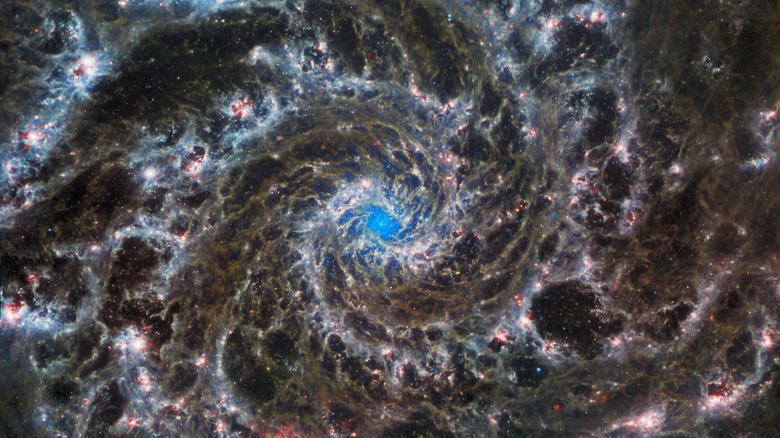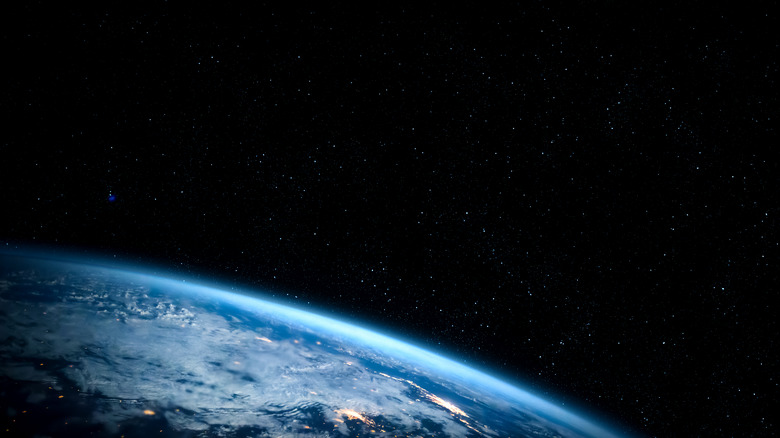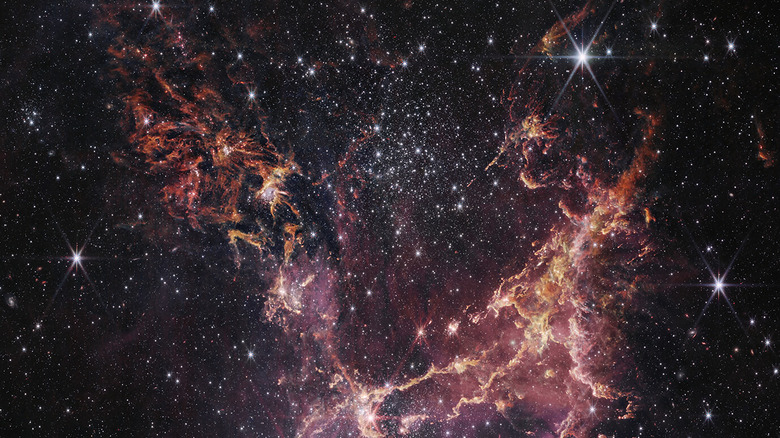How Theoretical Zero-Point Energy Draws Limitless Fuel From The Vacuum Of Space
As sci-fi fans will attest, scenes of the distant future aren't too difficult to imagine. We've got fleets of intergalactic ships exploring the inscrutable vastness of space. We've got legions of hardy settlers terraforming strange, new worlds. There's a great galactic chain of humanity forged through will, knowledge, and intellect stretching across the Milky Way and beyond. At least, that's one version. Some would describe a brutal, militaristic future for humanity, or one of disembodied consciousnesses and networks of planet-spanning artificial intelligence. But in each version, there's one crucial element that humanity can't do without: energy.
Energy is such a fundamental, critical component to civilization — off-world or not — that Soviet astronomer Nikolai Kardashev in 1964 labeled spacefaring civilizations based on how much energy they consumed; the higher the ranking, the more advanced, as Space.com explains. We're talking far, far beyond crude fuel like oil and coal. Earth isn't even a Type I civilization because we haven't harnessed all the energy available on our own planet. By contrast, a Type II civilization would be able to build an energy-harnessing structure like a Dyson sphere around its own sun, as described in Popular Mechanics. After all, all those intergalactic ships, stations, settlements, etc., need power from somewhere, same as they need materials.
So what if there was some nigh-infinite, nigh-magical source of energy that permeated the entire universe? What if it could be tapped at will, from anywhere at any time? That's zero-point energy in a nutshell.
Living in a time of free energy
Zero-point energy notwithstanding, all energy comes from one kind of source: inefficient systems. The sun burns through hydrogen and generates heat and light, same as a car burns through gasoline and produces heat, emissions, and so forth. Both are systems of higher energy aside systems of lower energy. Energy flows from the high system to the low because it always seeks disorder, aka "entropy," as sites like Study.com and ThoughtCo outline. Otherwise, if your hand was the same temperature as the sun, the sun wouldn't feel hot because there'd be no energy differential, i.e. heat.
All this inefficiency of systems — raging balls of nuclear fusion-burning stars spinning in the cosmos, pistons driving up and down in a car engine, combustible wood igniting to produce bonfires, etc. — exists because we live in a time of high physical order, as Forbes describes. That is, cosmologically, over the lifespan of the universe from the Big Bang to the cosmos' Heat Death, we live in an era — 13.8 billion years after the Big Bang — where the universe is speckled with lots of separate, discreet, energy-consuming and -producing systems. But by the time of the heat death, when all energy is perfectly uniform and smoothed out, there will be no heat or light because there will be no energy differences anywhere, as Big Think explains. That's a time of maximum entropy. And now? Now is a unique time of "free energy," per ThoughtCo.
The vacuum energy of space
But even though we live in a time of free energy, free energy isn't free, so to speak. Think of all the effort it takes just to drill into Earth and extract oil. The energy output produced by the oil has to outweigh the energy that goes into producing and setting up an oil rig, sending workers out there to eat, live, operate machines, etc., or else the whole venture just isn't worth it. Now imagine a grand, intergalactic future where humanity builds spaceships and off-world colonies. The energy demands would be beyond belief.
Zero-point energy could solve this problem, if indeed it could be tapped in the way that sites like Scientific American discuss. We mentioned energy differentials before — how contrary systems must be in states of disequilibrium in order for things like heat and light to flow, as Study.com describes. Zero-point energy follows the same principle. But rather than tap zero-point energy from a particular substance like coal, it exists in the very composition of the universe.
Inverse explains how the universe is permeated by quantum fields composed of virtual particles: particles that flicker in and out of existence, randomly. Those particles exist in the vacuum of space as a kind of baseline, perpetually existent energy. Physicists Richard Feynman and John Wheeler calculated that the virtual particles in something as small as the vacuum of a light bulb, if tapped, could generate enough energy to boil the Earth's oceans, per The Guardian.
The feet of the mighty gecko
Naturally, you can imagine that zero-point energy has garnered a lot of interest not only from physicists, but eager members of the public, as discussions on sites like Physics Forums demonstrate. It's a wonderful idea. Spaceships cruising around the cosmos and hoovering up virtual particles to use as limitless fuel? No more energy concerns for humanity ever again? If this sounds a bit too convenient or good to be true, that's because it is. We've got two hurdles to overcome before zero-point energy becomes a reality: proving that the vacuum energy of quantum fields exists, and engineering a machine that can tap it. The former we've done. The latter is complicated.
As the excellent YouTube channel PBS Space Time explains, we can demonstrate vacuum energy using a simple experiment: place two conducting plates near each other, but not touching, and the plates block some of the virtual particles between them. This lowers the vacuum energy between the plates, and the plates get pulled toward each other. Known as the Casimir effect, this is exactly what happens when geckos — you know, those cute little lizards — climb things. Thousand of microcilia (little hairs) on the gecko's feet press against a surface, and some of them get close enough to cause the Casimir effect, as the American Physical Society explains. Amazing as it sounds, this means that geckos climb surfaces because of quantum energy fields. This proves that vacuum energy exists.
Practical engineering problems
So how about engineering a zero-point energy engine? A Casimir engine would operate like gecko feet by blocking virtual particles between two plates. Then the plates get pulled together, and voila: instant energy. The only problem, as PBS Space Time explains? We'd have to force the plates apart every time, which would require the same amount of energy that they produce to begin with.
NASA, however, as Stanford University describes, apparently already built a "Casimir Rocket." Or as NASA calls it, a quantum vacuum plasma thruster, or "Q-thruster," as the Journal of Propulsion and Power describes. They built the prototype at NASA's Eagleworks Laboratories, a facility that specializes in cutting-edge propulsion. Even though NASA claims to have gotten thrust from their rocket, others say that the test's experimental design was inherently faulty because it wasn't conducted in the vacuum of space.
Besides such engineering problems, we really don't know how much vacuum energy exists in a given block of space, as Inverse says. We mentioned that physicists Richard Feynman and John Wheeler in The Guardian claimed that the virtual particles in the vacuum of a single light bulb contained enough energy to boil the Earth's oceans. PBS Spacetime, however, states that vacuum energy probably equals 10−8 erg/cm³. And since 1 erg equals 1 x 10-7 Joules, and we need 10 Joules to lift a 1-kilogram object by 1 meter (per Calculate Me), that's practically nothing.
A dream to inspire
So in the end, does harnessable vacuum energy exist throughout the universe's quantum field? In a manner, yes. But is it truly the freest sort of energy available in an era of cosmically free energy? Even taking nominally successful labors like that of NASA's Q-thruster into account, no. But in the future, could zero-point energy be a spewing font of endlessly consumable fuel, like a blowout in an oil field drowning a prancing oil baron in a torrent of black rain? Sadly, no. But as articles like that in Scientific American describe, some physicists and lay people alike continue to believe in zero-point energy like a magical messiah. Student forums like that on the University of Illinois field questions about zero-point energy's viability. Public debates like those on Maker Pro persist.
What are we to make of this ongoing curiosity with zero-point energy? Is it as simple as the human love of all one-step, silver-bullet solutions? Instead of going the long and difficult way to curbing humanity's voracious, climate-cooking energy consumption habits, for example, why not just build a machine that sucks all the carbon dioxide out of the air, like CNET describes? Or is it the near-mystical aura surrounding all things "quantum," compiled with a general and persistent lack of understanding within professional and public circles about quantum mechanics? Maybe it's not as cynical as that. Maybe zero-point energy, like all things sci-fi, just ignites the imagination and inspires visions of a greater, grander future.





